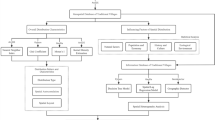Abstract
This study focuses on the meso-regional pattern of rangeland ecotypes in Central Tibet in relation to population density. Data on rangelands derive from a recent land-cover GIS database of China based on the 1:1,000,000 Land Use Map of China. Specific kinds of grassland and steppe are analyzed in relation to 466 township-level enumeration units selected from China's 1990 census in the Tibetan Autonomous Region. This methodology offers a finer geographic resolution than in all other available research reports, and results in a more detailed understanding of the kinds of rangeland resources available to Central Tibetan communities. Systemic land cover patterns are mapped, and reveal the importance of local interactions between population and rangeland ecotypes. Alpine meadow and alpine steppe predominate above the cultivation limit at approximately 4,200 m. In the densely settled valleys below this limit, dry steppe and scrub grassland predominate.
Similar content being viewed by others
References
Allan, N. J. R.: Human Geo-Ecological Interactions in Kuh Daman, a South Asian Mountain Valley. Applied Geography 5: 13-27 (1985).
Bishop, B. C.: The Changing Geo-Ecology of Karnali Zone, Western Nepal, Himalaya: A Case of Stress. Arctic and Alpine Research 10: 531-43 (1978).
Black, R.: Regional Political Ecology in Theory and Practice: A Case Study From Northern Portugal. Transactions of the Institute of British Geographers 15: 35-47 (1990).
Blaikie, P. and Brookfield, H.: Land Degradation and Society. London: Methuen. 1987.
Commission of the European Communities (CEC): China: Feasibility Study for an Integrated Rural Development Project in Panam County, Tibet. (Ref: CC/A/KAMP/1/B7-3000/93/155). 1994.
Chang, D. H. S.: The Vegetation Zonation of the Tibetan Plateau. Mountain Research and Development 1: 29-48 (1981).
China Statistical Press (CSP): Xizang Zizhiqu Disici Renkou Pucha Shougong Huizong Ziliao (Hand Tabulations on the 1990 Census of the Tibetan Autonomous Region). Beijing: CSP. 1990.
Cincotta, R. P., P.J. van Soest, J.B. Robertson, C. M. Beall, and M. C. Goldstein.: Foraging Ecology of Livestock on the Tibetan Changtang: A Comparison of Three Adjacent Grazing Areas. Arctic and Alpine Research 23: 149-161 (1991).
Clarke, G. E.: China's Reforms of Tibet, and their Effects on Pastoralism. Institute of Development Studies, Discussion Paper No. 237, University of Sussex, Brighton. 60 pp. 1987.
Ferrari, Alfonsa.: Mk'yen Brtse's Guide to the Holy Places of Central Tibet. Serie Orientale Roma 16 (1958).
Harbaugh, C. W.: Population Transfer in the TAR and other Tibetan Autonomous Prefectures and Counties. US Bureau of the Census, International Programs Center, Report, Washington, DC. 20 pp. 1994.
Hershkovitz, L.: Political Ecology and Environmental Management in the Loess Plateau, China. Human Ecology 21: 327-353 (1993)
Huang Weiwen.: The Prehistoric Human Occupation of the Qinghai-Xizang Plateau. pp. 201-219 in Göttinger Geographische Abhandlungen, Heft 95 (1994).
Jhaveri, N.: The Commons and Environmental Change in China. Chinese Environmental History Newsletter 1(2): 21-23 (1994).
Kessler, Peter: Das Historische Konigreich Mili. Laufende Arbeiten zu einem Ethnohistorischen Atlas Tibets (EAT), Vol. 47.1. Rikon/Zurich: Tibet-Institut (1982).
Kessler, Peter: Die Historischen Konigreiche von Ling und Derge. EAT, Vol. 40. Rikon/Zurich: Tibet-Institut (1983).
Kessler, Peter: Die Historische Landschaft Tehor. EAT, Vol. 41. Rikon/Zurich: Tibet-Institut (1984).
Lhundrub County Map: Tibet Autonomous Region Survey Bureau. Chengdu, Sichuan: Chengdu Cartographic Press. 1987.
Liu Yanhua.: Dynamics of Highland Agriculture in Lhasa District, Tibet. ICIMOD Occasional Paper No. 22. Kathmandu: International Centre for Integrated Mountain Development. 1992.
Meiners, S.: The Upper Limit of Alpine Land Use in Central, South and Southeastern Tibet. GeoJournal 25: 285-295 (1991).
Miller, D. J. and Schaller, G. B.: Rangelands of the Chang Tang Wildlife Reserve in Tibet. Rangelands 18: 91-96 (1996).
Moseley, C. and Asher, R. E. (eds): Atlas of the Worlds Languages. New York: Routledge. 1994.
Muldavin, J. S. S.: Impact of Reform on Environmental Sustainability in Rural China. Journal of Contemporary Asia 26: 289-321 (1996).
Namling County Map: Tibet Autonomous Region Survey Bureau. Chengdu, Sichuan: Chengdu Cartographic Press. 1989.
Nedong County Map: Tibet Autonomous Region Survey Bureau. Chengdu, Sichuan: Chengdu Cartographic Press. 1990.
Panam County Map: Tibet Autonomous Region Survey Bureau. Chengdu, Sichuan: Chengdu Cartographic Press. 1989.
Rinpung County Map: Tibet Autonomous Region Survey Bureau. Chengdu, Sichuan: Chengdu Cartographic Press. 1989.
Schweinfurth, U.: Mapping Mountains: Vegetation in the Himalaya. GeoJournal 27: 73-83 (1992).
Shetongmon County Map: Tibet Autonomous Region Survey Bureau. Chengdu, Sichuan: Chengdu Cartographic Press. 1988.
State Statistical Bureau (SSB): Zhongguo Minzu Renkou Ziliao (Tabulation on China's Nationality). Beijing: Zhongguo Tongji Chubanshe. 1994.
Tibetan Autonomous Region Population Census Office (TARPCO): Xizang Zizhiqu 1990 Nian Renkou Pucha Ziliao (Tabulations on the 1990 Population Census of the Tibetan Autonomous Region), 4 vol. Lhasa: Tibet Publishing House. 1992.
Troll, C.: Okologische Landschaftsforschung und Vergleichende Hochgebirgsforschung. Erdkundliches Wissen 11, ii-xii (1966).
Wu Chuanjun: 1:1,000,000 Land-use Map of China. Beijing: Science Press. 1990.
Wurm, S.A. (ed.) et al.: Language Atlas of China. Hong Kong: Longman. 1987.
Wylie, Turrell V.: A Standard System of Tibetan Transcription. Harvard Journal of Asiatic Studies 22: 261-267 (1959).
Wylie, Turrell V.: The Geography of Tibet According to the 'Dzam gling rgyas bshad. Serie Orientale Roma 25 (1962).
Zheng Du. 1983.: Untersuchungen zur Floristisch-Pflanzengeographischen Differenzierung des Xizang-Plateaus (Tibet), China. Erdkunde 37: 34-47 (1983).
Author information
Authors and Affiliations
Rights and permissions
About this article
Cite this article
Ryavec, K.E., Veregin, H. Population and rangelands in Central Tibet: a GIS-Based Approach. GeoJournal 44, 61–72 (1998). https://doi.org/10.1023/A:1006815130932
Issue Date:
DOI: https://doi.org/10.1023/A:1006815130932




